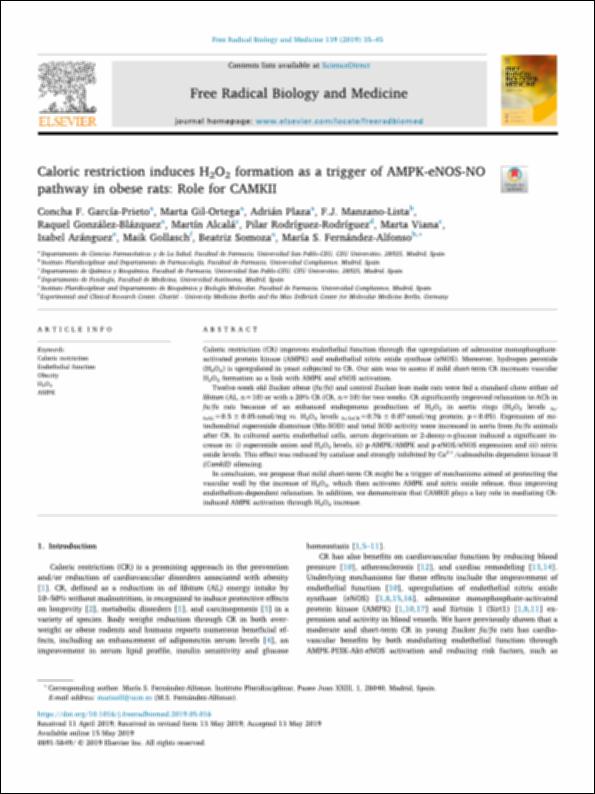Por favor, use este identificador para citar o enlazar este ítem:
http://hdl.handle.net/10637/14503Caloric restriction induces H2O2 formation as a trigger of AMPK-eNOS-NO pathway in obese rats: Role for CAMKII
| Título : | Caloric restriction induces H2O2 formation as a trigger of AMPK-eNOS-NO pathway in obese rats: Role for CAMKII |
| Autor : | Garcia-Prieto, Concha F. Gil Ortega, Marta Plaza de la Fuente, Adrián Manzano Lista, Francisco J. González Blázquez, Raquel Alcalá Díaz-Mor, Martín Rodríguez Rodríguez, Pilar Viana Arribas, Marta Aránguez, Isabel Gollasch, Maik Somoza Hernández, Beatriz Fernández Alfonso, María Soledad |
| Materias: | Endothelial function; Obesity; H2O2; AMPK; Caloric restriction |
| Editorial : | Elsevier |
| Citación : | Concha F. García-Prieto, Marta Gil-Ortega, Adrián Plaza, F.J. Manzano-Lista, Raquel González-Blázquez, Martín Alcalá, Pilar Rodríguez-Rodríguez, Marta Viana, Isabel Aránguez, Maik Gollasch, Beatriz Somoza, María S. Fernández-Alfonso, Caloric restriction induces H2O2 formation as a trigger of AMPK-eNOS-NO pathway in obese rats: Role for CAMKII, Free Radical Biology and Medicine, Volume 139, 2019, Pages 35-45, ISSN 0891-5849, https://doi.org/10.1016/j.freeradbiomed.2019.05.016. |
| Resumen : | Caloric restriction (CR) improves endothelial function through the upregulation of adenosine monophosphateactivated protein kinase (AMPK) and endothelial nitric oxide synthase (eNOS). Moreover, hydrogen peroxide (H2O2) is upregulated in yeast subjected to CR. Our aim was to assess if mild short-term CR increases vascular H2O2 formation as a link with AMPK and eNOS activation. Twelve-week old Zucker obese (fa/fa) and control Zucker lean male rats were fed a standard chow either ad libitum (AL, n=10) or with a 20% CR (CR, n=10) for two weeks. CR significantly improved relaxation to ACh in fa/fa rats because of an enhanced endogenous production of H2O2 in aortic rings (H2O2 levels fa/faAL=0.5±0.05 nmol/mg vs. H2O2 levels fa/faCR=0.76±0.07 nmol/mg protein; p<0.05). Expression of mitochondrial superoxide dismutase (Mn-SOD) and total SOD activity were increased in aorta from fa/fa animals after CR. In cultured aortic endothelial cells, serum deprivation or 2-deoxy-D-glucose induced a significant increase in: i) superoxide anion and H2O2 levels, ii) p-AMPK/AMPK and p-eNOS/eNOS expression and iii) nitric oxide levels. This effect was reduced by catalase and strongly inhibited by Ca2+/calmodulin-dependent kinase II (CamkII) silencing. In conclusion, we propose that mild short-term CR might be a trigger of mechanisms aimed at protecting the vascular wall by the increase of H2O2, which then activates AMPK and nitric oxide release, thus improving endothelium-dependent relaxation. In addition, we demonstrate that CAMKII plays a key role in mediating CRinduced AMPK activation through H2O2 increase. |
| URI : | http://hdl.handle.net/10637/14503 |
| Derechos: | http://creativecommons.org/licenses/by-nc-nd/4.0/deed.es openAccess |
| Fecha de publicación : | 13-may-2019 |
| Centro : | Universidad San Pablo-CEU |
| Aparece en las colecciones: | Facultad de Farmacia |
Los ítems de DSpace están protegidos por copyright, con todos los derechos reservados, a menos que se indique lo contrario.


